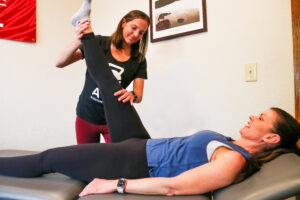Health & nutrition insights.
Physical Therapy – 10 Misconceptions
10 Misconceptions About Physical Therapy
The intention of physical therapy (PT) is to assist patients in returning to their desired lifestyle or activity level with reduced pain. PT’s are health professionals that deal with prevention, diagnosis, and treatment of physical impairments. This is accomplished through several different treatment techniques.
Kimi Reed, DPT, at Achieving Your Best, discusses some of the common myths of physical therapy.
-
Physical Therapy stands for “Pain and Torture”
 Physical therapy doesn’t have to be painful! While I like a good “pain and torture” joke, this isn’t really the case. Patients come in thinking therapy will be aggressive and full of torture techniques. Physical therapy is meant to reduce pain levels and improve mobility, so you can move around safely and not worry about loss of function or risking injury.
Physical therapy doesn’t have to be painful! While I like a good “pain and torture” joke, this isn’t really the case. Patients come in thinking therapy will be aggressive and full of torture techniques. Physical therapy is meant to reduce pain levels and improve mobility, so you can move around safely and not worry about loss of function or risking injury.
-
PT is just for post-surgery
Many people think PT is only for people who just had surgery. However, I help a lot of people who haven’t had surgery. I see patients who experience chronic pain, falls, balance issues, sports injuries, tendinitis, and general debility
-
PT is only for athletes

I do help athletes recover from sports-related injuries and return to sport, but PT is beneficial to all ages and levels of fitness. As patients age, they experience pain, weakness, and decreased mobility that may hinder their ability to function safely in the world. Physical therapy aims to return patients to whatever it is they love to do (playing sports, being active, gardening, walking, taking care of grand kids, etc!)
-
Physical therapy requires a physician referral
In Missouri, you do not need a referral to see a physical therapist in the state of Missouri. Being able to see a physical therapist without a referral will promote quicker intervention and help speed recovery. Patients enjoy Direct Access and do not legally need to see their doctor first.
-
PT is “one size fits all”

Physical therapy is very individualized care. Treatment starts off with a personalized, comprehensive evaluation. This includes measuring range of motion, flexibility, strength, balance, and special testing to determine pain or loss of function. Therapist and patient work together to set personal and individual goals of what they want to get out of therapy. For example, getting up from the floor, lifting their baby, riding their bike, etc.
-
PT is only exercise
There are a multitude of interventions and techniques that therapy uses. Many are familiar with strength and stretching. PT also includes manual therapies as well. This could be Graston-like techniques (muscle scrapping), joint mobilizations, trigger point release, soft tissue mobilization and different massage techniques, joint traction and distraction, and dry-needling.


-
You have to be in pain to benefit from PT

Pain is a driving force that typically brings one to physical therapy, usually after a bad accident or surgery. Physical therapists do a lot more than address pain. Their expertise in the human body can also assist with injury prevention and improved performance. Diagnosing issues in movement and function before they cause debilitating injuries can save you money, time, and frustration down the road.
-
A physical therapist is the same as an athletic trainer or personal trainer
Physical therapists are highly trained, and many have a Doctor of Physical Therapy degree. They are trained to treat orthopedic, neurological, vestibular, and many more conditions. Many exercises may look similar in the gym, physical therapy is geared more towards injury prevention and correcting muscle imbalances.
-
Your physical therapist will tell you to stop doing what you love

The main goal is for patients to resume activities they love! We understand the benefits of exercise or hobbies for physical and mental well-being. However, if you are experiencing an acute injury, it may be recommended to limit painful activities until you reach a certain stage of healing. Your physical therapist will recommend alternative activities to promote fitness until you are able to resume your desired hobby.
10. Physical therapy is expensive
Physical therapy is not as expensive as you might think. Several insurances may cover part of what therapy costs. Cash-based clinics could cost as little as $50-$200 per visit. If you compare the cost of physical therapy to the cost of a possible surgery and imaging, it’s affordable and reasonable.
